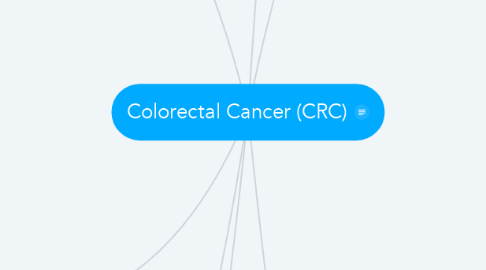
1. Diagnostic Screening
1.1. Primary Care Provider Intervention
1.1.1. Tests that Detect Polyps
1.1.2. Tests that Detect Cancer
1.1.3. Initial Blood Work
1.2. Epi ProColon
1.3. Stool-Based Screening
1.3.1. gFOBT
1.3.2. FIT
1.3.3. FIT-DNA
1.4. Direct Visualization Screening
1.4.1. Colonoscopy
1.4.1.1. Benefits
1.4.1.2. Screening Process
1.4.1.3. Adverse Outcomes
1.4.2. Computed Tomographic Colonoscopy
1.4.2.1. Benefits
1.4.2.2. Screening Process
1.4.2.3. Adverse Outcomes
1.4.3. Flexible Sigmoidoscopy
1.4.3.1. Benefits
1.4.3.2. Screening Process
1.4.3.3. Adverse Outcomes
2. Colorectal Cancer Staging
2.1. Stage 0
2.2. Stage I
2.3. Stage II
2.3.1. Stage IIA
2.3.2. Stage IIB
2.3.3. Stage IIC
2.4. Stage III
2.4.1. Stage IIIA
2.4.2. Stage IIIB
2.4.3. Stage IIIC
2.5. Stage IV
2.5.1. Stage IVA
2.5.2. Stage IVB
2.5.3. Stage IVC
3. Common Findings
3.1. Abdominal pain and cramping
3.2. Changes in bowel habits
3.3. Rectal bleeding
3.4. Fatigue
3.5. Anemia
3.6. Weight loss
3.7. Palpable abdominal mass
4. Strategies for Caring for CRC Survivors
4.1. Surveillance After Cancer Remission
4.1.1. Five Year Prognosis
4.1.2. Colonoscopy
4.1.3. CRC Stage II or greater
4.2. Common Presenting Symptoms of CRC Survivors
4.2.1. GI Symptoms
4.2.2. Urinary Symptoms
4.2.3. Psychological Symptoms
4.2.4. Chronic Pain
4.2.5. Risk of Fractures
5. Psychophysiology
5.1. Genetic Mutations
5.1.1. APC
5.1.2. MMR
5.1.3. Kras
5.1.4. DCC protein
5.1.5. P53
5.1.6. C-Myc
5.2. Environmental Factors
5.2.1. Smoking
5.2.2. Obesity
5.2.3. High Fat Consumption
5.2.4. Caffeine
5.2.5. Iron Deficiency Anemia
5.3. Immunity
5.3.1. IL10 & TGF-B
5.4. Inflammation
5.4.1. Inflammatory Bowel Disease (IBD)
5.4.1.1. Crohn's Disease
5.4.1.2. Ulcerative Colitis
5.4.2. Etiology
5.4.2.1. IL-6
5.4.2.2. p53
5.4.2.3. IL-10 & TGF-β
5.4.2.4. Toll-like receptors (TLRs)
5.4.2.5. Cyclooxygenase enzyme COX-2
5.4.2.6. ROS
5.4.2.7. TNF-α
6. Risk Factors
6.1. Life Style & Causative Factors
6.1.1. Smoking
6.1.2. Obesity
6.1.3. High Fat Consumption
6.1.4. Iron Deficiency Anemia
6.1.5. Caffeine
6.2. Older Age
6.3. Colorectal Polyps
6.4. Colon Cancer History
6.5. Inflammatory Bowel Disease
6.6. History of Cancer
6.7. Inherited Syndromes
6.7.1. Lynch Syndromee
6.7.2. Familial Adenomatous Polyposis (FAP)
6.7.3. Peutz-Jehers Syndrome
7. Treatment
7.1. Preventative Strategies
7.1.1. Aspirin
7.1.2. NSAID's & COX-2
7.1.3. Life Style Factors
7.1.3.1. Reduction in Alcohol
7.1.3.2. Reduction in Cigarette Use
7.1.3.3. Weight Reduction
7.1.3.4. Increased Physicall Activity
7.1.3.5. Diet
7.1.3.5.1. Low Fat Diet
7.1.3.5.2. High Fiber Diet
7.1.3.5.3. Plant Based Diet
7.1.4. Multivitamins
7.1.4.1. Calcium Suplements
7.1.4.2. Vitamin D
7.2. Chemotherapy Regiments
7.2.1. First Line Therapy
7.2.1.1. Oxaliplatin (Eloxatin)
7.2.1.1.1. Mechanism of Action
7.2.1.1.2. Treatment Consideration
7.2.1.1.3. APRN Consideration
7.2.1.1.4. Side Effects
7.2.1.1.5. Infection
7.2.1.2. Irinotecan
7.2.1.2.1. Mechanism of Action
7.2.1.2.2. Treatment Consideration
7.2.1.2.3. Side Effects
7.2.1.2.4. Infection
7.2.1.3. Fluorouracil
7.2.1.3.1. Mechanism of Action
7.2.1.3.2. Treatment Considerations
7.2.1.3.3. APRN Considerations
7.2.1.3.4. Side Effects
7.2.1.3.5. Infection
7.2.1.4. Leucovorin
7.2.1.4.1. Mechanism of Action
7.2.1.4.2. Treatment Considerations
7.2.1.4.3. APRN Considerations
7.2.1.4.4. Side Effects
7.2.2. Second Line Therapy
7.2.2.1. Avastin
7.2.2.1.1. Mechanism of Action
7.2.2.1.2. Treatment Considerations
7.2.2.1.3. APRN Considerations
7.2.2.1.4. Side Effects
7.2.2.1.5. Infection
7.2.2.2. Erbitux
7.2.2.2.1. Mechanism of Action
7.2.2.2.2. Treatment Considerations
7.2.2.2.3. APRN Considerations
7.2.2.2.4. Side Effects
7.2.2.2.5. Infection
7.2.2.3. Vectibix
7.2.2.3.1. Mechanism of Action
7.2.2.3.2. Treatment Considerations
7.2.2.3.3. APRN Considerations
7.2.2.3.4. Side Effects
7.2.2.3.5. Infection
7.3. Surgical Intervention
7.3.1. Interventions
7.3.2. Adverse Outcomes
7.4. Radiation
7.4.1. Interventions
7.4.2. Adverse Outcomes

